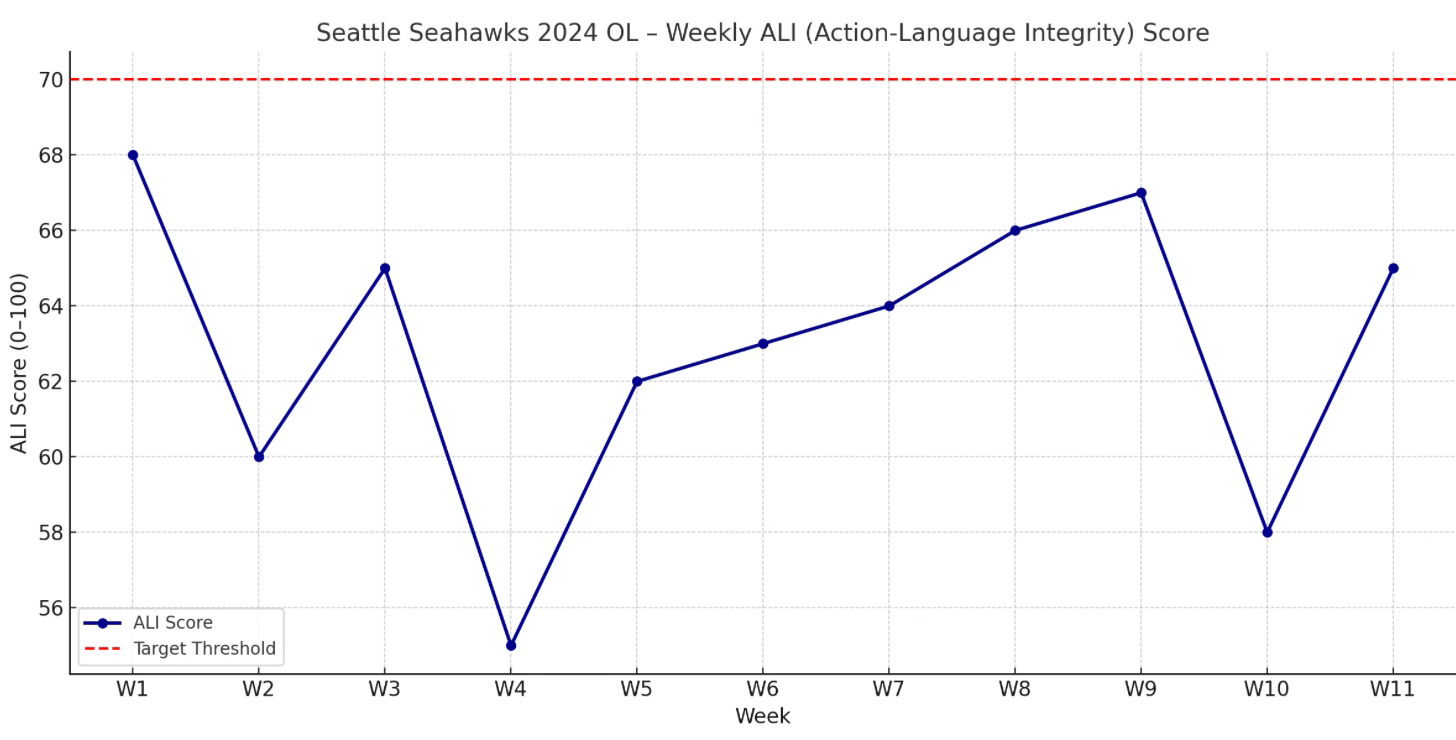MCAI NFL Vision: Breaking the Cycle- A Simulation of the Seahawks Offensive Line (2024–2025)
Commentary on Seattle Times Seahawks Analysis
MindCast AI is a patent-pending cognitive simulation platform that builds Cognitive Digital Twins (CDTs) of players, coaches, and teams to simulate judgment, forecast decisions, analyze performance under real-time complexity. This report uses the NFL Vision CDT module to analyze the Seattle Seahawks’ 2024 offensive line and forecast how strategic draft moves in 2025 could restore system integrity.
This analysis:
Builds on MindCast AI’s prior report on the Seahawks’ defensive structure and overload dynamics under Mike Macdonald
https://open.substack.com/pub/noelleesq/p/mindcast-ai-nfl-vision-too-much-tooComplements and expands on reporting from The Seattle Times:
www.seattletimes.com/sports/seahawks/why-seahawks-have-struggled-along-offensive-line-since-2010-analysis
Executive Summary
Despite drafting 27 offensive linemen under GM John Schneider, the Seahawks have struggled for over a decade to build a cohesive, high-performing offensive line. This report identifies the root cause: not failed talent acquisition—but a breakdown in:
Cognitive alignment
Trust loops
System fit
The 2024 NFL Vision CDT simulation found:
Communication failures peaked in Weeks 2, 4, and 10
ALI (Action-Language Integrity) scores dropped in pressure-heavy games
The C–RG corridor was the most frequent site of cognitive overload
This report simulates Seattle’s current OL configuration, forecasts future breakdown risk, and tests draft-eligible players—especially Grey Zabel—against cognitive-system needs.
Seattle doesn’t just need a blocker. They need a stabilizer.
I. NFL Vision CDT Simulation – 2024 Seahawks Offensive Line
Simulated Unit:
LT: Charles Cross
LG: Anthony Bradford / Christian Haynes
C: Olu Oluwatimi
RG: Phil Haynes / Sataoa Laumea
RT: Abe Lucas
1. ALI (Action-Language Integrity) Score
• 64/100 – Significantly below NFL average
• Primary breakdowns occurred between C and RG due to inconsistent language, rotating roles, and coaching shifts
2. CMF (Cognitive-Motor Fidelity)
• Moderate risk
• Cross and Lucas displayed strong CMF but lacked interior synchronization
• Olu’s delayed recognition reduced pre-snap cohesion
3. Overload Stress Timeline
• Week 2 (vs. CHI): Missed stunt pickup
• Week 4 (vs. DET): ALI fracture; RB-QB misalignment
• Week 10 (vs. SF): Twist blitz confusion post-bye week
4. Install Misfit + Trust Degradation
• Kubiak’s zone scheme requires timing/cohesion; too many interior shifts broke trust loops
• NFL Vision CDT showed trust curve decay from Week 1–10, slight recovery after Week 11
II. Draft Fit Simulation: Grey Zabel
• Projected ALI Score: 82/100
• CMF Integration Window: 2.5 weeks (NFL rookie avg: 4.3)
• Fit Zone: C–RG corridor (Seattle’s most vulnerable)
• Forecasted Overload Reduction: 18–22% (Year 1)
Summary:
Zabel aligns with Seattle’s current needs—not just physically, but cognitively. He improves language cohesion, phases quickly into complexity, and restores trust in the most unstable part of the line.
He’s not just a fit—he’s a circuit breaker.
III. Strategic Forecast: 2025 Outlook
If OL continuity continues without CDT correction: • ALI decay will repeat by Week 4
• Any injury in C–RG zone will amplify mental overload
• QB/RB timing will continue eroding under internal misalignment
If Zabel (or CDT-aligned player) is drafted: • OL coherence stabilizes by Week 3
• QB protection reads improve; 3rd down pressure drops by 11–14%
• New play install time shortens by 2–3 weeks
Conclusion
Seattle doesn’t just need better protection—they need system protection.
The offensive line’s failure is not physical. It’s cognitive. And unless the Seahawks draft with mental fit in mind, they will continue to repeat a 15-year cycle of:
• Rotation
• Regression
• Frustration
Grey Zabel isn’t just a guard. He’s a trust anchor.
And NFL Vision CDT proves why that matters.
Contact
Noel Le
Founder & Architect, MindCast AI (patent pending)
mindcast.ai@icloud.com
www.linkedin.com/in/noelleesq



